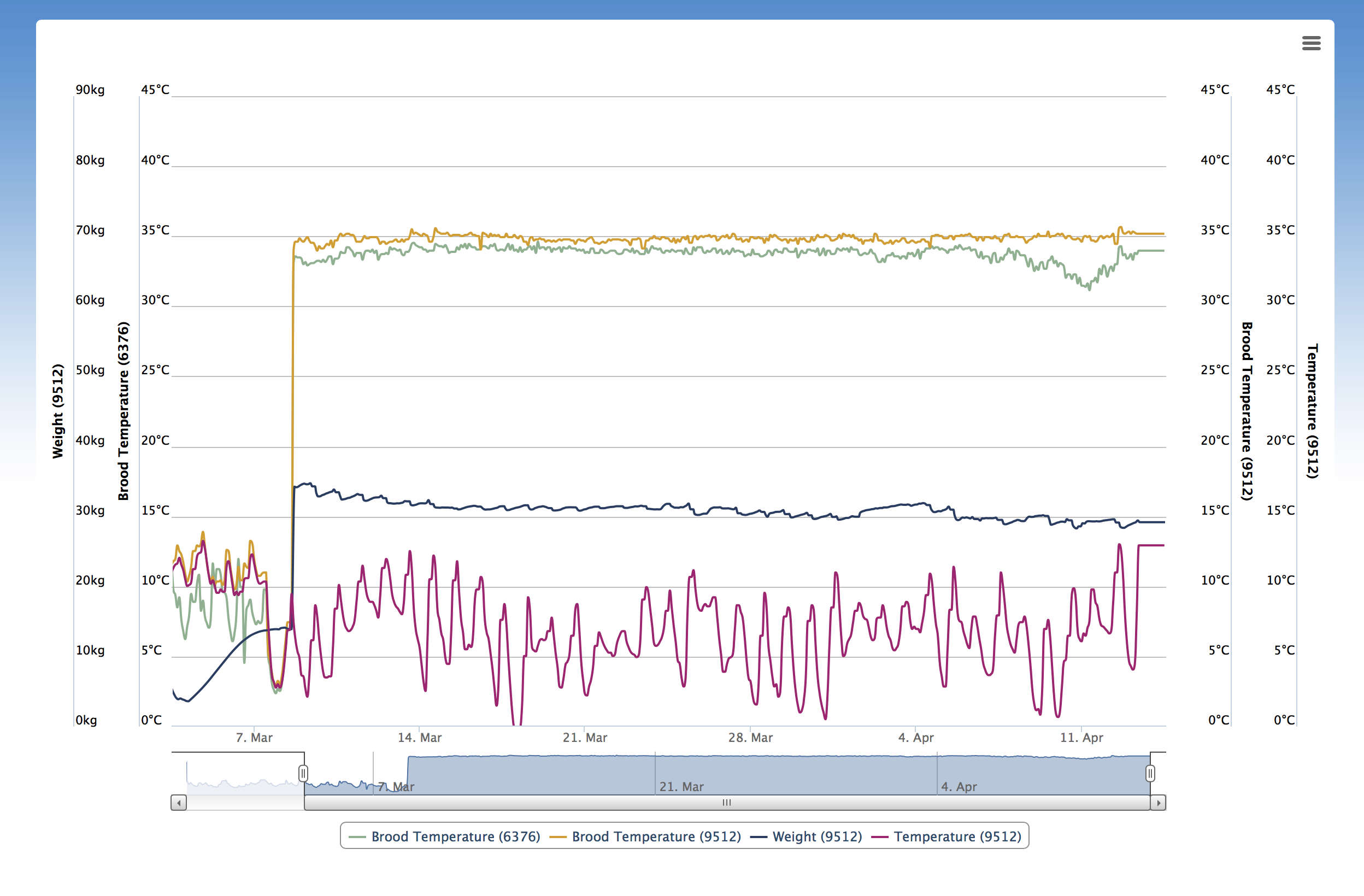Installing a remote hive monitoring system should give the armchair beekeeper some measure of comfort – especially in a cold spring when opening hives is out of the question. However, it ain’t necessarily so!
Earlier this week my hive monitors raised 2 causes for concern plus a puzzle.
Here’s the graph. Click it for a close-up:
 Key
Key
- The two uppermost lines are plots of the brood nest temperature in two hives at a distant apiary – green = Hive 1, yellow = Hive 2;
- The black line is the hive scale under Hive 2;
- The pink line is the ambient temperature (outside the hive).
As you can see from the pink line, the weather has been chilly for all of April, rarely above 10 degrees, so opening hives has been out of the question.
The comforting part – up until the 8th or 9th April was that despite the cold weather – the temperature in the brood nests of both hives was well above ambient and pretty steady.
Also – the weight of hive 2 was only going down very slowly. Nothing to worry about there.
However…
Concerns
- Around 5th April the green line started to fall suggesting something amiss with the queen in Hive 1;
- The weight of stores in Hive 2 is steadily going down – there was a 5 kg drop in the last month and that’s 11lb which ever way you look at it. How much of the remaining 27kgs was stores and how much was the weight of the hive?
- Hive 1 is running a degree or so cooler than Hive 2. This could be a quirk in the works or something else… what though… That’s the puzzle.
Fortunately the weather improved slightly this week permitting a hive inspection.
Hive 1
- One yr old Queen present and laying;
- The reason for the dip in temperature was that the brood nest had moved away from the probe, leaving it stranded at the chilly perimeter;
- Apart from that there is no obvious reason why this colony should have a cooler brood nest than hive 2.
Hive 2
- In this hive is a 3 year old queen – very strong;
- Plenty of stores so no need to worry about that;
- In fact – it needs a super.
Brood nest temperature and the Native Bee.
The gap on the graph between the two brood nest temperature plots is probably an anomaly but is interesting if it isn’t.
The best thing to do would be for me to swap the two monitors to test it. If they continue more or less the same then there is a quirk in the system. If they cross over then Hive 1 really is running cooler than the other.
Lower brood nest temperature could be a characteristic of native bees and monitoring might be a way of picking them out. It just so happens that the queen in Hive 1 is a queen I bred and reared here. The queen in Hive 2 isn’t.
What next?
Rightly or wrongly I clipped the blue queen in Hive – after all it was quite warm and the bees were calm. If I have damaged her then it will show in the brood nest temperature.
It remains to be seen if the bees actively more the nest away from the sensor again.
I can continue to monitor the weight of Hive 2 from this distance and now that I’ve hefted them I know they can lose another 5kg before I need to worry.
Conclusions
Remote hive monitors can give reassuring information but there are limits.
You need to know:
- the baseline;
- that the sensors continue to be correctly positioned;
- the monitors are functioning properly or you will get false alarms.
Click here for How to Set up your Arnia Monitors
Click here for How Install your Arnia Monitors
Click here for more about Remote Bee Hive Monitoring and applications
Click here for a video overview of the Basic Hive Scale
Click here for video instructions on how to assemble your Basic Scale
Click here for How to Make your own Scale Hive
Click here for Bees, Honey and a Scale Hive
Click here for Useful Arnia Hive Scale Data
Copyright © Beespoke.info, 2016. All Rights Reserved.
